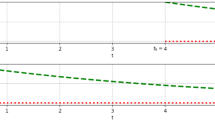Abstract
A dynamic model of optimization of R&D intensity is studied for analyzing the effect of the spillover technology assimilation on techno-economic growth. The research focuses on the issue of a reasonable balance in the R&D investment policy between the indigenous technology stock and exogenous technology flow. On the basis of the concavity properties of the Hamiltonian, a nonlinear stabilizer sustaining proportional techno-economic growth is constructed. Trends of optimal R&D intensity are examined depending on the values of the model macroeconomic parameters and the feedback variables. Econometric analysis shows that additional investments and restructuring of these sources for knowledge absorption could have the effect of increasing returns and provide a strong leverage for reaching qualitatively higher levels of sales, technology development, and consumption index.
Similar content being viewed by others
References
Arrow, K.J.: Applications of control theory to economic growth. In: Production and Capital: Collected Papers, vol. 5, pp. 261–296. Belknap Press of Harvard University Press, Cambridge (1985)
Carlson, D.A., Leitmann, G.: The direct method for a class of infinite horizon dynamic games. In: Deissenberg C., Hartl, F. (eds.) Optimal Control and Dynamic Games: Applications in Finance, Management Science, and Economics, vol. 7, pp. 319–334. Springer, New York (2005)
Cellini, R., Lambertini, L., Leitmann, G.: Degenerate feedback and time consistency in differential games. In: Hofer, E., Reithmeier, E. (eds.) Modeling and Control of Autonomous Decision Support Based Systems, pp. 185–192. Shaker, Aachen (2005)
Grossman, G.M., Helpman, E.: Innovation and Growth in the Global Economy. MIT Press, Cambridge (1991)
Intriligator, M.: Mathematical Optimization and Economic Theory. Prentice-Hall, New York (1971)
Tarasyev, A.M., Watanabe, C.: Optimal dynamics of innovation in models of economic growth. J. Optim. Theory Appl. 108(1), 175–203 (2001)
Tarasyev, A.M., Watanabe, C., Zhu, B.: Optimal feedbacks in techno-economic dynamics. Int. J. Technol. Manag. 23(7–8), 691–717 (2002)
Reshmin, S.A., Tarasyev, A.M., Watanabe, C.: Optimal trajectories of the innovation process and their matching with econometric data. J. Optim. Theory Appl. 112(3), 639–655 (2002)
Pontryagin, L.S., Boltyanskii, V.G., Gamkrelidze, R.V., Mishchenko, E.F.: The Mathematical Theory of Optimal Processes. Wiley, New York (1962)
Krasovskii, A.N., Krasovskii, N.N.: Control under Lack of Information. Birkhäuser, Boston (1995)
Subbotin, A.I.: Generalized Solutions for First-Order PDE. Birkhäuser, Boston (1995)
Tarasyev, A.M.: Control synthesis in grid schemes for Hamilton–Jacobi equations. Ann. Oper. Res. 88, 337–359 (1999)
Borisov, V.F., Hutschenreiter, G., Kryazhimskii, A.V.: Asymptotic growth rates in knowledge-exchanging economies. Ann. Oper. Res. 89, 61–73 (1999)
Dolcetta, I.C.: On a discrete approximation of the Hamilton–Jacobi equation of dynamic programming. Appl. Math. Optim. 10, 367–377 (1983)
Feichtinger, G., Wirl, F.: Instabilities in concave, dynamic, economic optimization. J. Optim. Theory Appl. 107, 277–288 (2000)
Watanabe, C.: Econometric Analysis of Technological Innovation. JUSE Press, Tokyo (2000)
Watanabe, C., Zhu, B., Griffy-Brown, C., Asgari, B.: Global technology spillover and its impact on industry’s R&D strategies. Technovation 21(5), 281–291 (2001)
Author information
Authors and Affiliations
Corresponding author
Additional information
Communicated by G. Leitmann.
The research was sponsored by the SIMOT Program of the Japanese Ministry of Education, Science and Technology.
A.M. Tarasyev was supported by the Russian Fund for Basic Research, Grants 05-01-00601, 05-01-08034, Russian Fund for Humanities, Grant RFH 05-02-02118a, and by the Program for the Sponsorship of Leading Scientific Schools, Grant NSCH-791.2003.1.
Rights and permissions
About this article
Cite this article
Ane, B.K., Tarasyev, A.M. & Watanabe, C. Construction of Nonlinear Stabilizer for Trajectories of Economic Growth. J Optim Theory Appl 134, 303–320 (2007). https://doi.org/10.1007/s10957-007-9256-3
Published:
Issue Date:
DOI: https://doi.org/10.1007/s10957-007-9256-3




